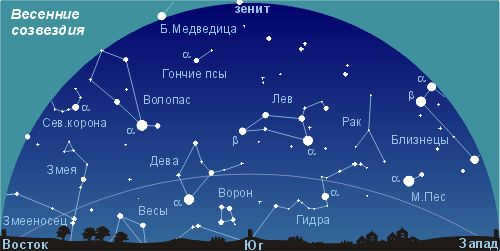
The springtime night sky never fails to captivate and awe. Its vibrant and deep hues, along with the multitude of constellations and twinkling stars, make for a truly mesmerizing sight.
During this month, there are several noteworthy constellations that can be observed. Below, you will find more information about these celestial formations.
March – May: The Constellations of the Spring Sky
Pump
Reword the text, making it unique, using the English language and preserving the HTML markup:
Pump
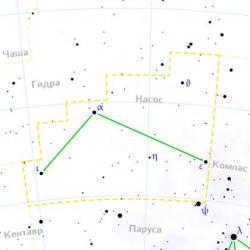
The constellation Pump is relatively small and contains a handful of faint stars in the southern hemisphere. It can be observed with the naked eye on a clear night, without the need for special equipment. It consists of approximately 20 stars, many of which are barely visible without aid. Among them are some more noticeable stars with a brightness of up to 5m. When connected, they form an obtuse triangle, with the brightest being a 4th magnitude orange-colored star.
One of the unique aspects of the Pump constellation is the presence of numerous objects that are of great interest to those studying deep space. One such object is the well-known galaxy NGC 2997, which is located within the constellation and is currently moving away from us at a speed of 1100 kilometers per second.
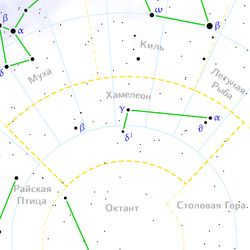
The Chameleon constellation is incredibly small and cannot be seen with the naked eye, even by experienced astronomers. It does not have any visible stars and covers an area of only 132 square degrees. These unique features place Chameleon at the 79th position in the ranking of constellations based on size.
The distinctive shape of Chameleon is a rhomboid formed by four connected stars. Additionally, this constellation contains a peculiar cluster consisting of only 8 young stars. These stars are estimated to be around 8 million years old, and their presence was only detected through the X-ray radiation they emit.
Container for Food
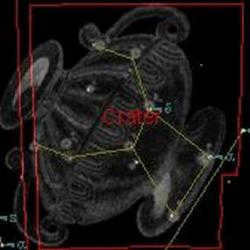
The name of this constellation is derived from its distinctive shape, which closely resembles a genuine clay vessel. Among the 88 constellations currently known, this particular one ranks as the 53rd largest. While the majority of its stars are barely visible, a total of 20 stars within the Cup can be seen under favorable weather conditions. However, during the spring season in Russia, the outlines of this constellation can still be observed. The optimal time for viewing is towards the end of March and the beginning of April.
Regrettably, the Cup constellation does not contain a significant number of unique or intriguing celestial objects. Nevertheless, W. Herschel managed to draw attention to this constellation through his discovery of a spiral galaxy with a central bar.
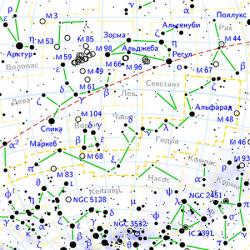
Hydra is the top-ranked constellation in terms of its size, spanning over 1300 square degrees. This makes it impossible to miss, especially during the month of April. Despite its considerable size, it can be challenging to distinguish Hydra from other celestial objects.
Within Hydra, there is a notable star that will be familiar to fans of the movies “Transformers” and Sukhinov’s works – R Hydra. This star is a variable star, and its shock wave was documented for the first time in 2006.
Leo
Leo is a name of Latin origin that means “lion”. It is a popular name for boys and is often associated with qualities such as strength, courage, and leadership. Leo is also the fifth astrological sign of the zodiac, represented by a lion. People born under this sign are said to be confident, ambitious, and charismatic.
Leo can also be short for Leonardo, a name that means “brave lion”. This name is often associated with the famous artist and inventor, Leonardo da Vinci. Leonardo is known for his artistic talent, scientific discoveries, and innovative ideas.
Overall, Leo is a powerful and majestic name that carries with it a sense of strength and nobility. It is a name that has been used for centuries and continues to be popular today. So, if you are considering naming your child Leo, you can be sure that they will have a name that is both unique and meaningful.
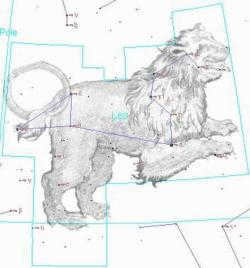
The constellation Leo is widely recognized as the primary constellation in the sky during the months of March and April. Many astronomy enthusiasts use Leo as a reference point to locate other constellations in the spring sky. Within Leo, there are numerous fascinating celestial objects, each deserving of attention. Some of these objects can even be observed without the need for a telescope. Finding Leo may only take a few minutes, but the sights you behold will leave a lasting impression!
One of the most notable objects in Leo is Regulus, which bears a striking resemblance to a heart. Regulus shines with a brightness 160 times greater than that of the Sun. Other objects in Leo, such as Algeiba and Denebola, may not be as luminous, but they still possess their own unique qualities that make them worthy of admiration.
Small Lion
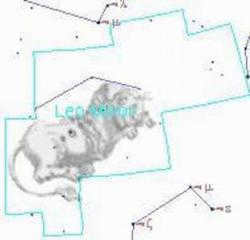
Leo Minor is visible to the naked eye, making it accessible to anyone. In April, amateur astronomers are drawn to its 34 bright stars that shine prominently in the sky. This region is also known for its frequent comet sightings.
Located near the Big Dipper, Leo Minor is easy to spot. The most well-known feature of this constellation is Praecypia, an orange giant star. Praecypia is located 98 light years away from Earth.
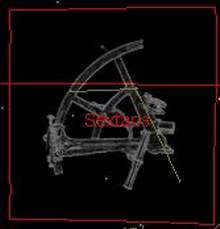
This is a lesser-known constellation that can sometimes only be observed with the aid of a telescope. It lacks prominent stars but still garners attention for its collection of galaxies, each with its own distinct size and shape, as well as several distinct species.
Thanks to its favorable positioning, Sextant is easily visible in both hemispheres. The best time to observe it in our country is in April, and it can be located near Hydra. The most intriguing star within Sextant is LHS 292, a red dwarf.
Ursa Major
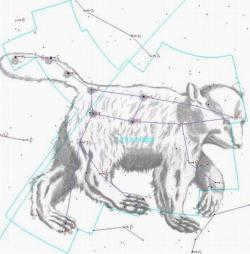
Even individuals uninterested in astronomy are familiar with the Big Dipper. This group of stars is a constellation that forms various shapes when combined. Interestingly, the Big Dipper has significantly grown in size over the past few centuries. It has caught the attention of numerous scientists worldwide, who are thoroughly examining it.
Thanks to its luminosity, the stars in this constellation are clearly visible during clear weather. Even without a telescope, one can observe a total of 125 stars.

As spring arrives, the arrangement of constellations in the starry sky of the northern hemisphere undergoes a transformation. When looking south at night in March, the constellations visible in front of you are the ones associated with March. The constellations that remain behind, in the north, are the non-setting constellations. On the left side, towards the east, the constellations are just beginning to rise. They will not fully appear until April. And on the right side, towards the west, are the constellations associated with February.
The constellations of the spring sky: March April May
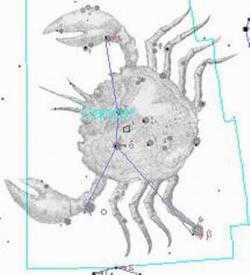
Cancer is an ancient constellation in the sky and is one of the least noticeable. The ancient Greek writers Eratosthenes and Ovid mentioned it, and it was also included in Ptolemy’s list, which counted 9 stars within it.
The brightest star, β Cancer, goes by the name Altarf. It is a 14th magnitude star located approximately 290 light years away from Earth. It has a distinct orange hue.
Within the Cancer constellation, two other prominent stars can be observed: the Northern Donkey, a giant white star, and the Southern Donkey, an orange star. The remaining stars in the constellation include Akubens, Sertan, Tegmen, Presepa, and Nan.
Within the Cancer constellation, astronomers have discovered two star clusters. One of these clusters is easily visible to the naked eye, appearing as a hazy spot positioned near the center of a “letter Y” shape. This particular cluster is commonly known as the Nursery or Beehive, with its official name being M44. It contains approximately 350 stars.
The second cluster, located slightly to the west, is smaller in size. In official catalogs, it is referred to as M67, while ancient astronomers nicknamed it “Donkeys”. This cluster consists of over 500 stars, with an estimated age in the billions of years.
The Cancer constellation can be observed throughout Russia, provided it is a clear night without the presence of the moon. It is located between the constellations of Gemini and Leo. The optimal time for observing this constellation is during early spring, specifically in the first few days of March. The constellation itself resembles an inverted letter Y.
Small Canine
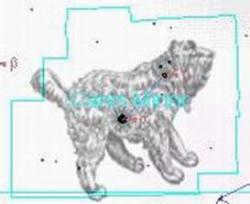
During the spring season, the Lesser Dog constellation can be easily observed. It can be seen all across Russia, but its visibility is particularly favorable in the southern regions. One can easily locate this constellation by looking for its brightest star, Procyon, which is situated to the south of the Gemini constellation. Another helpful reference point is the Orion constellation, as the Lesser Dog runs parallel to the Milky Way in conjunction with it.
When viewed from Earth, the constellation appears as an elongated line, with two brilliant stars gleaming at its extremities.
The most brilliant star in the constellation of the Lesser Dog is Procyon. This massive celestial body, like many of its counterparts, is a binary star system. Procyon Alpha, a white subgiant, shines with a brightness that is seven times greater than that of the Sun and resides a mere 11.7 light-years away from our planet. It ranks among the top seven brightest stars in the northern hemisphere. Procyon Beta, on the other hand, is classified as a white dwarf. Alongside Bedelgeuse and Sirius, Procyon forms the Winter Triangle when observed in the night sky.
Gomeis, the second largest and most radiant star in the Lesser Dog constellation, is encompassed by a nebula of gas. This scorching celestial object is also visible to the naked eye. It is known to have a size three times that of the Sun, a mass four times greater, and a luminosity 250 times brighter.
In addition to these two prominent stars, the Lesser Dog constellation contains six other stars with a magnitude of 4, twenty stars with a magnitude of 5, and forty-one smaller stars.
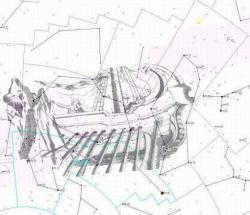
The constellation “Argo’s Ship” (Kiel, Stern, Sails, Compass)
The constellation Kiel has been known since ancient times. It was included by Ptolemy in the general constellation “Argo’s Ship”. Later, in the XVIII century, this giant was divided into three constellations: Kiel, Korma, and Sails.
The constellation Kiel can be observed south of the 37th parallel of the northern hemisphere. Kiel is distinguished by its brightest star, Canopus. It is situated between two star formations known as the Diamond Cross and the False Cross, which are the asterisms of Kiel.
The shape of the constellation resembles the keel of a ship. However, it is not visible in the territory of Russia.
The constellation consists of 206 stars that can be seen with the naked eye. Here are some of the most notable ones:
- Canopus, which is located 700 light-years away, is the second brightest star in the sky. It shines 15,000 times brighter than our Sun. In ancient times, instead of Polaris, Canopus served as a crucial reference point for sailors.
- Avior, also known as Epsilon Kiel, is a double star situated 630 light-years away from our solar system. It is positioned to the south of Canopus. In close proximity to Avior, there are two other fascinating celestial objects – a hot blue star and an aging orange giant.
There is another fascinating star in the constellation known as Eta Kila. In China, it goes by the name “Altar of Heaven.” It used to be regarded as the most brilliant star in the celestial sphere. However, it started to dim significantly after reaching its peak around 1843. Despite this, it can still be observed without the aid of telescopes. Numerous scientists theorize that Eta Kila is not merely a single star but rather a binary system encompassed by three nebulae: Kylia, Keyhole, and Homunculus.
Bobcat
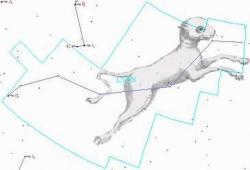
The constellation Lynx is a dim but prominent constellation in the northern hemisphere. It can only be observed with the naked eye on a clear moonless night. However, it can be seen throughout Russia for most of the year, except during the summer when it is partially hidden behind the horizon.
A good way to locate the Lynx constellation is by using the Big Dipper and the Ascendant. By drawing an imaginary line from the “handle of the bucket” of the Big Dipper to the east, towards Menkalinan (the Beta star of the Ascendant), this line intersects with the Lynx constellation, which stretches like a long broken line from north to south.
The constellation was first discovered by the Polish astronomer I. Hevelius in the 17th century. It is believed that Hevelius named it Lynx because one must have the keen eyesight of this predator to spot its stars.
There exist 92 stars within the constellation of Lynx. However, it lacks any of the most brilliant ones. Notable examples include:
- Alpha Lynx, also known as Alvashak, is a variable star situated 203 light-years away. It currently exhibits an orange hue, weighs 55 times more than the Sun, and shines 673 times brighter.
- Star 38 Lynx, or Maculata, is a double star of a white color and has a magnitude of 4.
- Star 31 Lynx, frequently referred to as the Spike, is an orange giant and the fourth brightest star in the constellation. It is located 390 light years away.
Lynx contains several other captivating celestial objects. Among them is the Intergalactic Wanderer, a globular cluster that roams the Milky Way. Some scientists theorize that it originated from a galaxy that was obliterated by our own Milky Way.
Yet another thing is a spiral galaxy. Its shape is similar to that of a flying saucer, which is why it earned the nickname “UFO Galaxy”. It is positioned around 25 million light years away and can only be seen with the aid of a high-powered telescope.
Korma
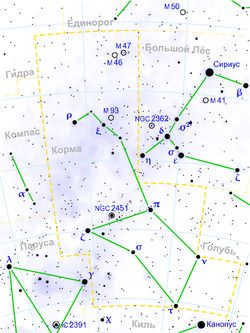
The constellation Korma can be observed in the Milky Way and is visible throughout Russia, with the best visibility being south of the 39th parallel. Its shape resembles an elongated polygon. To locate Korma, it is helpful to use Sirius as a reference point. By drawing an imaginary line through the stars that form the Big Dog constellation and extending it to the southeast, we can find Korma in the sky.
Previously, Korma was considered a part of the Argo Navus constellation, along with Kiel and Sail. However, it has since been separated, and now Korma consists of 241 stars. Among them, Korma is the largest and occupies an area of over 673 square degrees in the sky.
Ahadi is the second brightest star in the constellation of Korma. It is a supergiant of the K-type and can be found approximately 900 light years away. Ahadi shines with a brightness that is 19 thousand times greater than that of the Sun.
Aside from the stars in the Korma constellation, astronomers also study various other celestial objects in deep space. Among the notable objects are several fascinating star clusters and nebulae. One of these nebulae has been nicknamed the “Rotten Egg”.
Compass
A compass is a navigational instrument that shows direction relative to the Earth’s magnetic field. It consists of a magnetized needle that aligns itself with the magnetic field, allowing the user to determine north, south, east, and west. The compass has been used for centuries by travelers, explorers, and sailors to navigate and find their way. It is a crucial tool for outdoor activities such as hiking, camping, and orienteering. With advancements in technology, digital compasses are now available, but the traditional magnetic compass remains a reliable and essential tool for navigation.
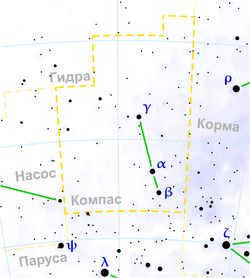
This constellation, known as Compass, consists of 43 stars and is mostly visible to the naked eye. In Russia, it can be best observed in the southern regions, as well as in the southern parts of the central regions.
The shape of the Compass constellation resembles an elongated line perpendicular to the Stern and Keel. Initially, there was a desire to name it the Mast of Argo Navus, but this name did not gain popularity.
Alpha Compass is the brightest star in this constellation. It is a blue variable luminary located approximately 845 light years away. It is generally considered a 4th magnitude star, although some scientists argue that it may be a third magnitude star. The reduced brightness of this star is believed to be due to interstellar dust obscuring our view.
T Compass’s supernova is a binary star system, comprising of a white giant and a white dwarf. It occasionally experiences sudden increases in brightness. The most recent incident of this nature was documented in 1967.
Compass boasts numerous celestial objects in its vicinity. Among them is the spiral galaxy NGC 2613. Situated in close proximity to Alpha Compass, it bears a striking resemblance to our own Milky Way in terms of size and classification.
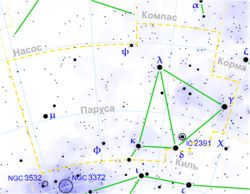
This is a brand new formation resulting from the splitting of Argo Navus. Sails comprises of a total of 195 stars, many of which are visible to the naked eye.
In terms of shape, the constellation bears a resemblance to a triangle. In Russia, it can be observed in the southern regions, specifically south of the 53rd parallel. For navigation purposes, it is more convenient to use the Compass constellation. By extending an imaginary line from Compass and continuing it further south, the line will intersect with Regor – the brightest star in Sails, serving as one of the vertices of the “triangle”.
Regor is also known as Suhail. However, it is more commonly referred to as the Phantom Gem of the Southern Sky due to its emission of bright rays instead of the typical dark absorbing rays, resulting in an unusual spectrum.
Regor is a star system called Gamma Sails, which is unique because it consists of six stars. Among these stars, Gamma-1 is a bright blue-white subgiant, and Gamma-2 is the brightest star in the system and appears as a double star, with a blue color.
Delta Sails is another star system that features two double stars. Delta C and Delta D are the brightest stars in this system, although they are gradually fading. Interestingly, Delta Sails is expected to become the South Polar Star in approximately 7,000 years.
Both Regor and Delta Sails stars are part of an asterism known as the False Cross. Additionally, there are other fascinating objects in this region of space, such as the Eight Flashes Nebula, which contains a hot white dwarf at its center.
The Soaring Sea Creature
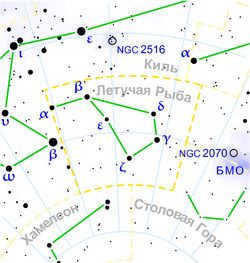
This particular constellation, known as the Flying Fish, was initially discovered in the 16th century by P. Plancius. Comprised of a total of 31 stars, it unfortunately cannot be seen from Russia, but rather can only be observed south of the 15th parallel.
When looking at the Flying Fish constellation, one may notice its shape resembles that of a trapezoid, with one side being extended. It can be located by focusing on the nearby constellations of Kiel and Goldfish.
In the night sky, the Flying Fish constellation may not appear particularly remarkable. Out of its 31 stars, only around 20 are visible to the naked eye, with just three stars in the constellation having a stellar magnitude greater than 3.
One notable star within the Flying Fish constellation is Beta Flying, which is a variable orange giant situated approximately 108 light years away.
Additionally, the gamma star within this constellation is a binary system, consisting of an orange giant and a white-yellow dwarf.
NGC 2442, a spiral galaxy in the Flying Fish, is the most captivating entity in far-off space. Its shape bears a striking resemblance to the letter S in English. Experts posit that this galaxy emerged from the fusion of two separate galaxies. At its core lies a gas cloud, utterly lacking in stars.

Centaurus, Virgo, and Veronica’s Hair are the most prominent constellations visible in the northern hemisphere. They contain a vast collection of galaxies. Veronica’s Hair alone has more than two thousand galaxies. Similar galaxy clusters can also be found in the constellations of Virgo and Canis Major.
The constellations of the spring sky: March April May
Hound Dogs
Dogs that belong to the hound group are commonly referred to as hound dogs.
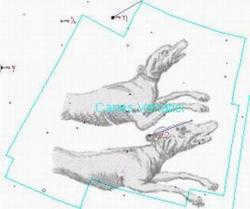
Among the 88 known constellations, this constellation is recognized as one of the largest in the northern hemisphere, ranking 38th in terms of its area.
The story behind its discovery is quite fascinating. In the 16th century, the renowned Polish astronomer I. Hevelius identified this cluster of stars as an independent constellation. Prior to that, these magnificent stars were perceived as part of the Volopassus constellation and symbolically represented a club held by the mythical giant.
The constellation Hound Dogs contains 57 stars that are visible to the naked eye.
- The primary star of Hound Dogs is named Cor Caroli, also known as the Heart of Charles. This binary star system has served as a model for various variable stars.
- The secondary star of Hound Dogs is called Chara. This dwarf star bears a striking resemblance to our Sun and is often considered a promising location to search for extraterrestrial life.
- One notable member of the Hound Dogs constellation is the dwarf star La Superia. Its vibrant red hue makes it particularly captivating. La Superia is among the coolest stars and ranks among the brightest J-class objects, specifically carbon stars.
Among the celestial objects within the Hound Dogs constellation, the most captivating are the Whirlpool and Sunflower spiral galaxies, along with the immense globular star cluster M3, which can be observed near the border with Wolfsbane.
The Constellation of Centaurus
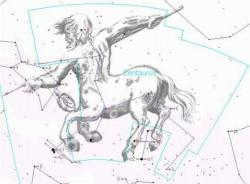
Centaurus is a vast constellation that spans an impressive area of 1,060 square degrees. However, it can only be fully observed in the southern hemisphere, below the 26th parallel. In Russia, only the northern part of Centaurus is visible. The “head” of Centaurus lies to the south of the Hydra constellation, while one of its “arms” extends towards the Wolf constellation. The “legs” of Centaurus can be found on either side of the Southern Cross.
With a total of 270 stars that can be seen with the naked eye, Centaurus is a captivating sight.
Beta Centauri, also known as Hadar, is frequently referred to as a double star and is ranked as the 11th most luminous star in the celestial sphere. If one were to draw an imaginary line connecting Alpha Centauri to Hadar, this line would intersect with the iconic Southern Cross constellation. These particular stars hold the maritime nickname of “southern signposts.”
Within the northern hemisphere of outer space, one can observe the captivating Omega Centauri globular cluster. This cluster consists of a multitude of stars situated in close proximity to one another. Remarkably, it is the nearest globular cluster to our planet Earth.
Another intriguing celestial object to behold is the lens-shaped galaxy NGC 5128. The majority of its stars emit a red hue. Although it is ranked as the fifth most brilliant galaxy, it is solely visible within the southern hemisphere.
Veronica’s Tresses
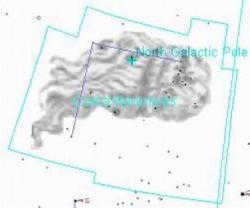
Veronica’s Hair is a small constellation in the northern hemisphere that consists of 64 stars that can be seen with the naked eye. In the past, it was considered to be part of the Leo constellation, but in 1601 T. Brahe separated it as its own constellation.
This constellation is easily visible in Russia, particularly during early spring. To orient yourself, look for Volopas to the east and Leo to the west. If you draw an imaginary line between Arcturus and Mufrid, you will find Diadem, which is the brightest star in Veronica’s Hair.
Diadem is a double star, with two objects orbiting around each other. It is located 65 light-years away from Earth.
One of the prominent stars in Veronica’s Hair is Beta Star, which is a dwarf. It bears a striking resemblance to our Sun.
An exceptional feature of this constellation is the North Pole of the Galaxy. Additionally, Veronica’s Hair is home to over a thousand large galaxies and more than thirty thousand small galaxies.
The most extensive cluster in the constellation is Melotte 11, which boasts more than forty 5th magnitude stars. It forms an inverted letter V shape that is easily visible to the south of the Hound Dogs constellation.
In the spring, we will once again be able to observe the Big Dipper constellation in the night sky. Notably, its dipper has shifted and is no longer positioned in the same way as it was in the fall or winter. Let’s locate Polaris. Surprisingly, it remains in the same position, while the other stars of the Little Dipper have shifted.
The Big Dipper, Little Dipper, and Cassiopeia constellations can be seen in the sky all year round.
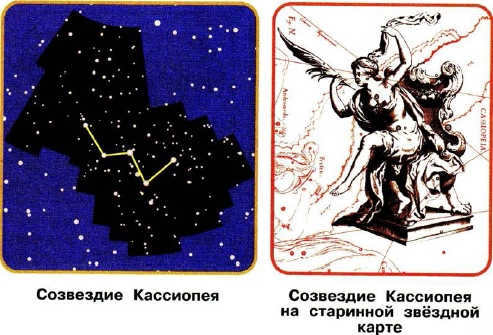
The ruler of the celestial realm.
Let’s now shift our attention to the opposite hemisphere of the celestial sphere. In this region, the arrangement of stars has undergone a transformation in comparison to the winter season. New constellations have emerged, with the constellation Leo being of particular fascination. The prominent stars within this constellation form a shape resembling a majestic lion, the king of beasts.
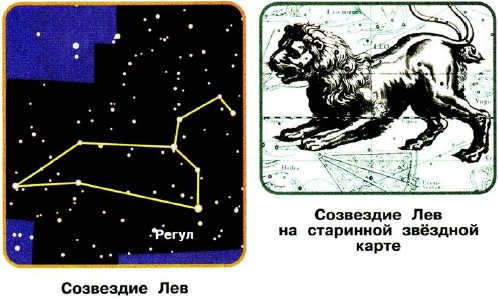
- Why does the position of Polaris change at different times of the year ¦ while the constellations of the Big Dipper, Little Dipper, and Cassiopeia rotate around it (11)?
During the spring season, we can observe the well-known constellations of the Big Dipper and Little Dipper in the night sky. Alongside them is the constellation Cassiopeia, while the constellation Leo can be found in the opposite part of the sky.
Exploring the constellations that are visible in the spring months
Which stars and constellations can be seen from the northern hemisphere of the Earth (specifically from the territory of Russia) in the spring months?
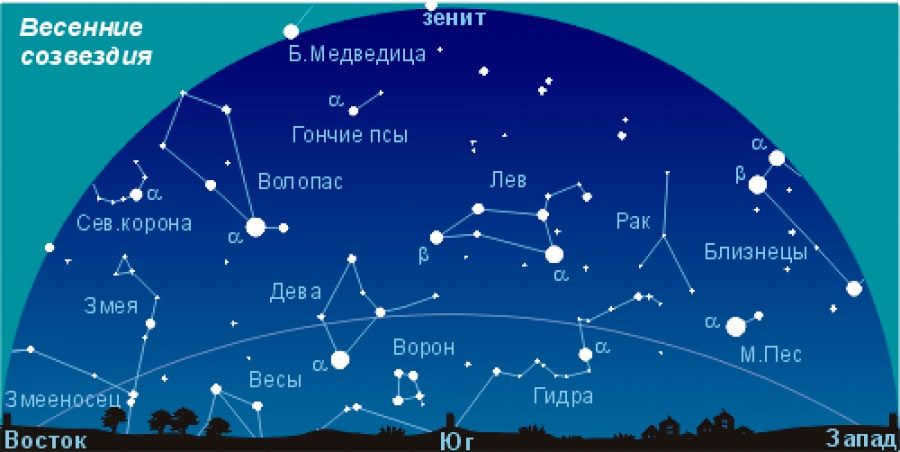
During the spring season, the prominent constellation known as Big Bear is positioned directly above us at its zenith. Its tail extends towards the southern region of the sky, specifically to the southeast, while its head points towards the west and its feet towards the south.
Based on this information alone, without the need to gaze at the sky, one can anticipate the presence of the Leo constellation in the southern direction, as well as the rising of the Wolopassus constellation. Additionally, the Ascendant and all the magnificent winter constellations within the Big Dipper’s head can be observed tilting towards the sunset in the west.
A glimpse at the southern hemisphere of the sky reveals that the winter constellations, such as Orion, the Big Dog, and Taurus, have already descended below the horizon. The only remaining figures are the Twins, positioned in the western direction, with the Little Dog located beneath them.
Towards the south, beneath the Big Dipper, the star Regulus gleams in the constellation of Leo, occupying the same position that Aldebaran holds during winter. In the eastern direction, Arcturus burns brightly at a similar altitude, while a third prominent star, known as the Colossus of Virgo, shines to the south, with its magnitude almost reaching 1st. This star is situated approximately halfway between Arcturus and Regulus, but at a lower position, where Sirius would be found in winter.
Within the constellation of Virgo, three additional small stars of 3rd magnitude can be observed, forming a diamond-shaped quadrangle alongside the Colossus.
These constellations can be found in the southern sky during the spring season. Additionally, we can mention a small quadrangle of four stars known as the Raven, which is located below and to the right of Virgo. Below Leo, there are a couple of stars, one of 2nd magnitude and one of 3rd magnitude, from the constellation Hydra.
In the northern sky, directly north of Polaris, we can spot the constellation Cassiopeia. Below Cassiopeia, we can see the upper stars of the constellation Andromeda. In the northwest, we can observe the upper stars of the constellations Ascendant and Perseus from the constellation Andromeda. In the northeast, we can witness the rise of the constellations Lyra and Swan.
If we briefly describe the autumn night sky from the territory of Russia, we would see the following constellations:
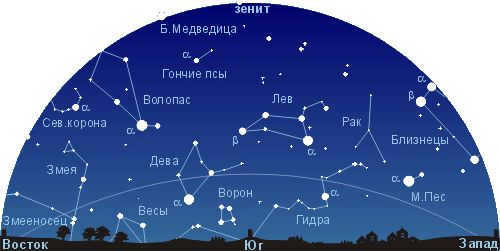
The arrival of spring brings about a change in the starry sky in the Northern Hemisphere. As winter slowly fades away, so do the freezing temperatures and familiar images of distant space that we are used to seeing at night. Instead, the constellations of the spring sky take center stage, led by the majestic Leo, as they grace the celestial stage.
| March | Cancer – Canis Minor – Carina – Lynx – Phoenicopterus – Pyxis – Vela – Volans |
| April | Puppis – Chamaeleon – Crater – Hydra – Leo – Leo Minor – Sextans – Ursa Major |
| May | Canes Venatici – Centaurus – Coma Berenices – Corvus – Crux – Musca – Virgo |
Constellations in the sky during the season of spring
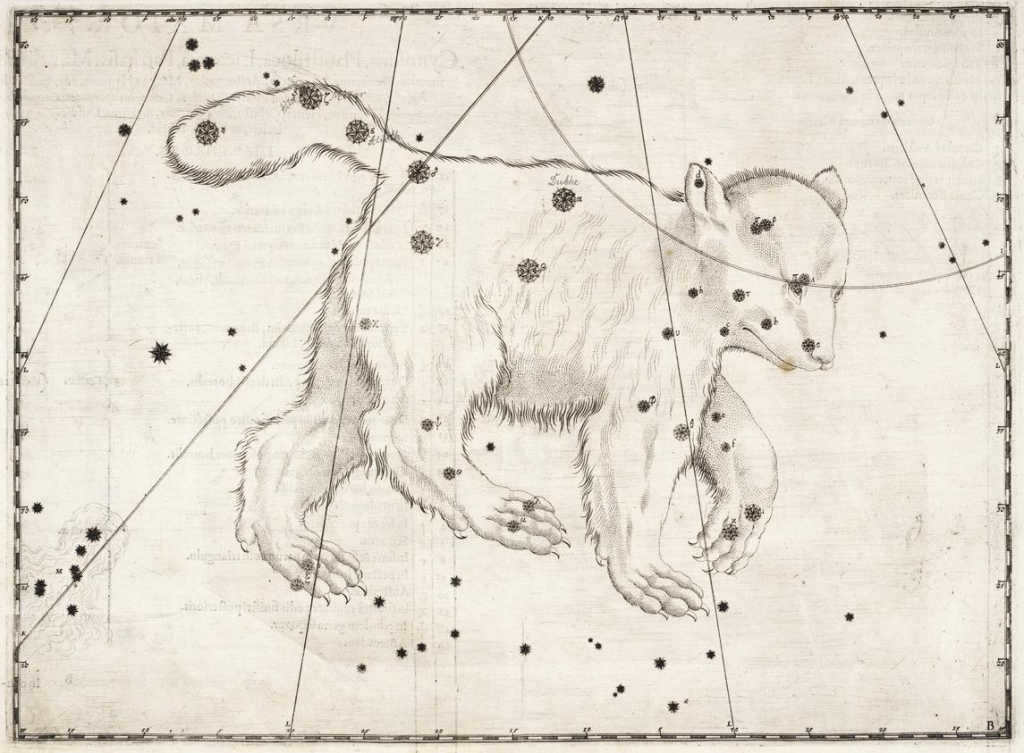
To locate the majestic ruler of the animal kingdom, the simplest method is to initially observe the prominent cluster of stars known as the Big Dipper. Positioned just below the “ladle” of this celestial formation, one can witness the radiant glow of Regulus, which is referred to as Kalb al-Asad in Arabic, signifying the lion’s courageous heart. By extending the imaginary handle of the celestial ladle, it becomes possible to identify Arcturus, an illustrious star situated within the constellation of Volopassus.
Virgo holds the second position in the list of constellations
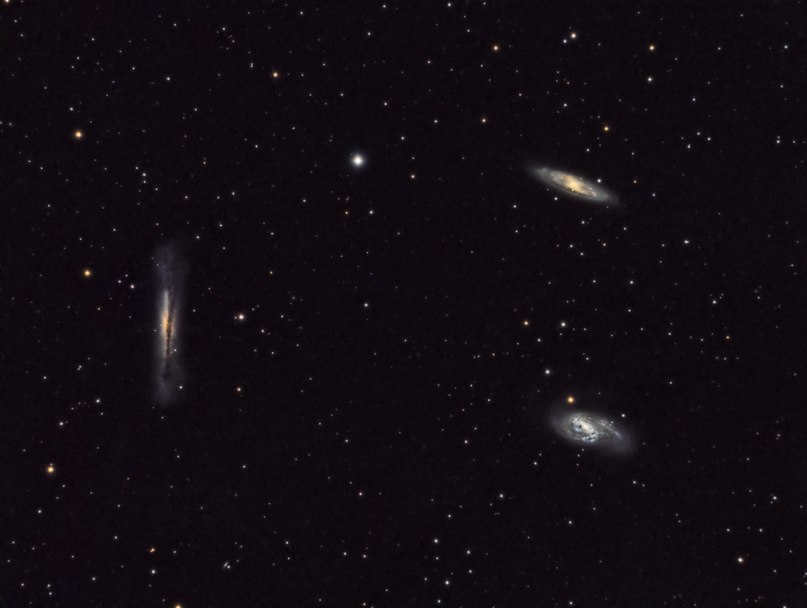
Among Leo and below both, you can find the majestic Virgo – one of the biggest constellations. Only Hydra surpasses its size, stretching its body close to the horizon. Virgo is adorned with Spica, the brightest star in this part of the celestial sphere. On a clear night, you can attempt to locate the Cancer constellation between Leo and the receding Gemini, although it consists of faint stars, it is of zodiacal significance and therefore holds special allure.
As spring gains momentum, the winter constellations gradually fade away, descending lower and lower towards the horizon, until they eventually disappear.
The primary constellations of the spring sky
Many individuals are interested in acquiring the knowledge to navigate the stunning night sky. However, for beginners, it can appear as a chaotic yet breathtaking sight. It may seem impossible to comprehend the complexity of the celestial bodies.
The idea of diligently studying the starry sky with the aid of a map can be overwhelming to many. However, understanding how to navigate among the stars is crucial for practical observations. How does one locate Jupiter or Saturn in the vast expanse of the sky? Where can the variable star g Hercules be found? How does one identify the globular cluster M3? For those familiar with the basic positions of the luminaries and armed with a starry sky atlas, answering these questions is relatively easy.
How does one acquire the skills to navigate the sky without succumbing to boredom or mental exhaustion during the learning process?
The main principle in studying any case is a gradual transition from simplicity to complexity. This principle is especially important in practical astronomy. If you want to learn how to navigate the sky, it’s best to start with something small: Try memorizing the brightest stars that can be seen in the evening and the most prominent star patterns – constellations or asterisms. Once you can confidently distinguish Vega from Deneb, and the constellation of the Swan from the constellation of the Eagle, you can then use these constellations and stars as a starting point to find and memorize smaller and less noticeable star patterns.
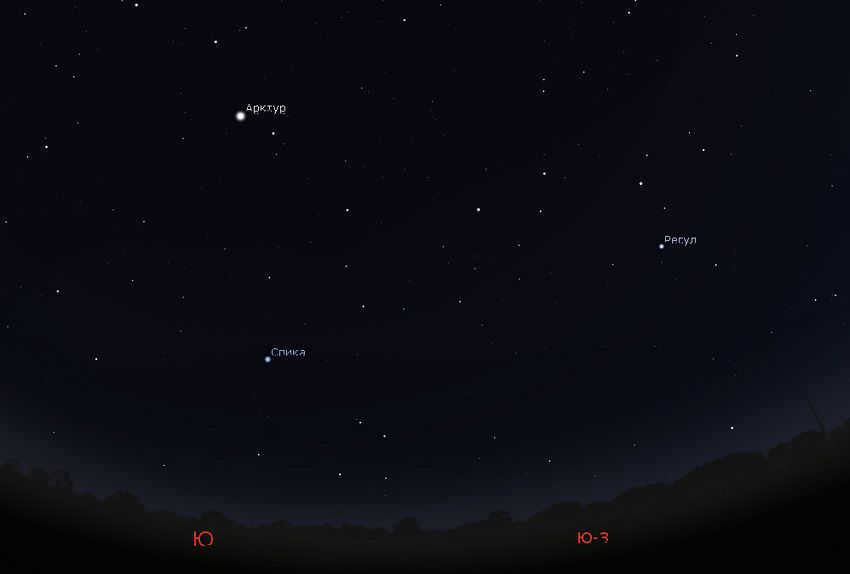
Regulus, Spica, and Arcturus are the three primary stars that dominate the spring sky. Image: Stellarium
The star Regulus and the Leo constellation
Regulus is the prominent star within the Leo constellation, which is identifiable by its large trapezoid shape comprising of four stars, as well as the asterism known as the Sickle, representing the chest and head of the mythical beast. Regulus is situated in the lower right corner of the Leo constellation’s figure, known as the Trapezium. In early spring, Leo can be observed in the eastern skies during the evenings, and towards the end of spring, it can be seen in the southwest during dusk.
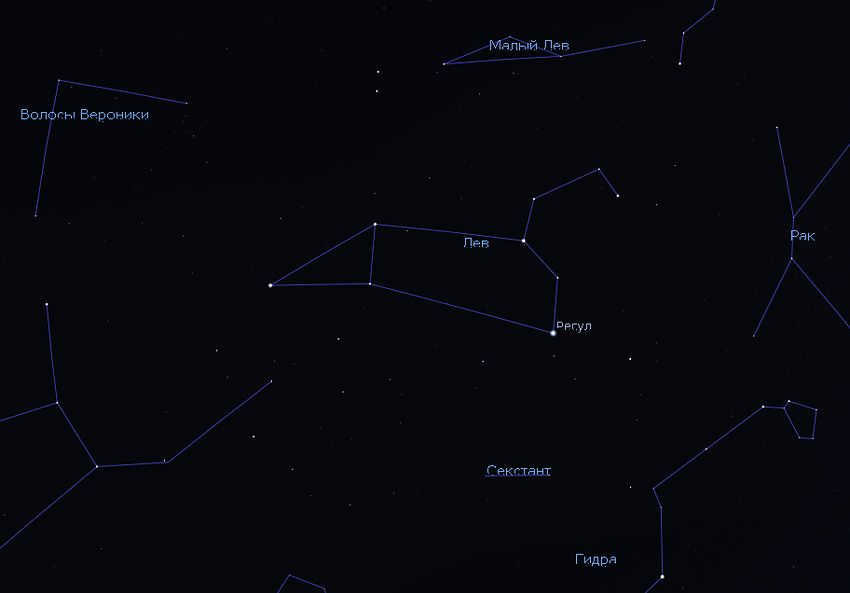
The figure forming the body and head of the celestial predator makes the constellation Leo easily recognizable. Figure: Stellarium
Regulus is located west of two other bright stars, Arcturus and Spica. In the evenings of the second half of spring, these stars can be observed in the southern side of the sky.
Arcturus is the brightest star in the northern celestial hemisphere. It stands out due to its reddish color and its prominent position high up in the sky during April and May. Take note of the chain of stars that extend from Arcturus, moving to the left and upward, forming the pattern of the constellation Boötes. Some people perceive it as a large letter P, while others see it as a parachute with Arcturus as the parachutist at its base.
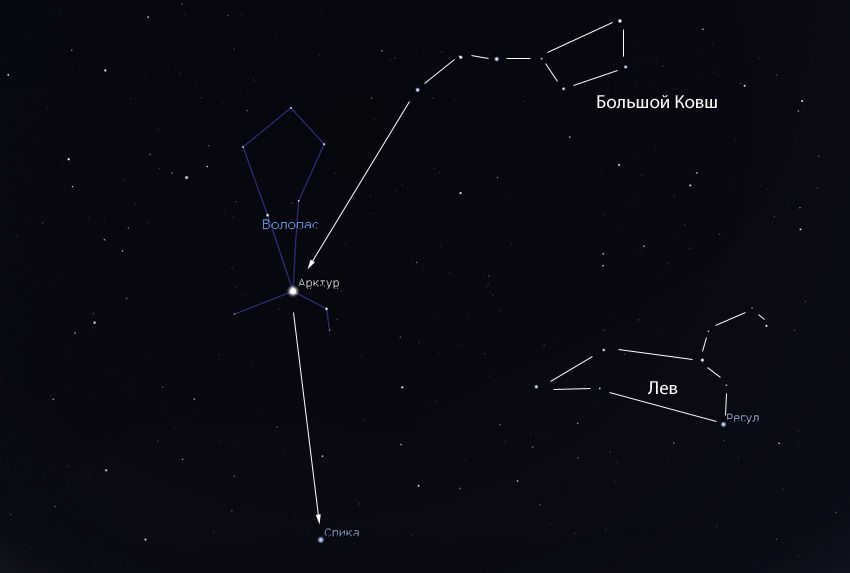
Arcturus and Spica can be located by starting from the stars of the Ursa Major’s ladle. Image: Stellarium
Despite the fact that Arcturus is a highly luminous star and immediately catches your attention in the sparsely populated spring sky, there is another method to search for it. Look up at the zenith during the evening hours. Straight above you, you will notice the famous Ursa Major’s ladle. (If you are facing north, the ladle will appear inverted – the bottom of the ladle will be facing south!) Now, mentally connect the two outermost stars of the ladle’s handle with a line. Extend this line, with a slight curve, approximately 30 degrees to the south. The line will indicate the location of Arcturus!
If you continue extending this line further south, you will reach Spica, the third brightest star in the spring sky.
The star Spica and the constellation Virgo
Spica is the primary star of the expansive yet not particularly prominent constellation Virgo. The most notable shape of Virgo is an asymmetrical quadrilateral, with Spica positioned in the lower corner. This zodiacal constellation extends on either side of the celestial equator, but lacks stars that are brighter than the 3rd magnitude (except for Spica), making it difficult to discern its outline in urban areas due to street lights.
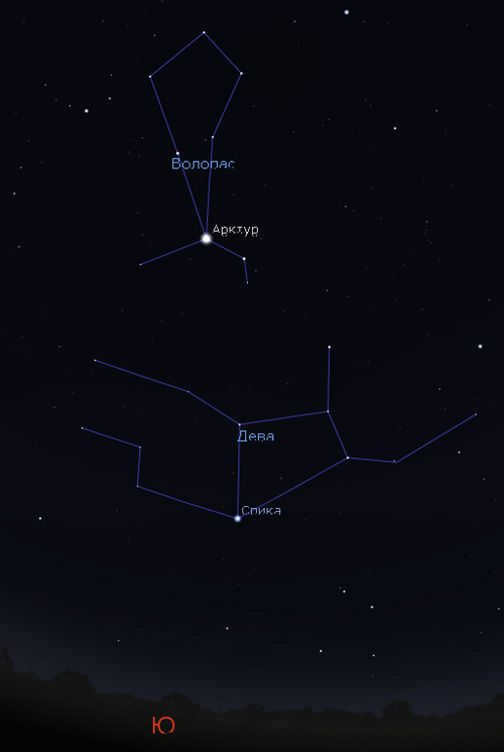
The constellations Volopassus and Virgo are visible in the sky during the spring. This image was captured by Stellarium.
As the ecliptic passes through the constellation Virgo, the Moon and planets frequently make appearances here. In 2017, for instance, there was a planet, Jupiter, located near Spica. Jupiter’s brightness outshone that of any of the stars. Beginners often find it challenging to distinguish between stars and planets. However, if you have a good understanding of the brightest stars and the main constellations visible during this time of year, you will not be confused by any planet. You will immediately recognize that you are not looking at a star!
The spring sky’s constellations
The southern part of the sky offers a view of the constellations that dominate the spring season. The optimal time to observe them is in April. Russian residents will have no trouble spotting Hydra, Virgo, Cancer, Cup, Lion, Raven, and Centaurus. During this period, the night sky appears both dark and enigmatic. This article will explore the constellations visible in the spring sky, their associated myths, and any unique characteristics they possess.
Groups of stars from mythology
When studying the constellations visible in the spring sky, it is important to acknowledge the significance they held in historical science for centuries. In ancient times, people attributed various processes and phenomena to the stars. In the following section, we will explore the main groups of stars with their historical references and detailed characteristics.
This particular constellation can be found south of the Big Dipper and east of the Little Dog. Its distinctive pattern of a mane and torso makes it easily recognizable to the average observer. It appears as if a predator is preparing to leap. In the past, it was believed that the appearance of such spring constellations in the sky heralded the birth of a great king in the near future. The brightest star in this constellation is Regulus, which is classified as a first-magnitude star.
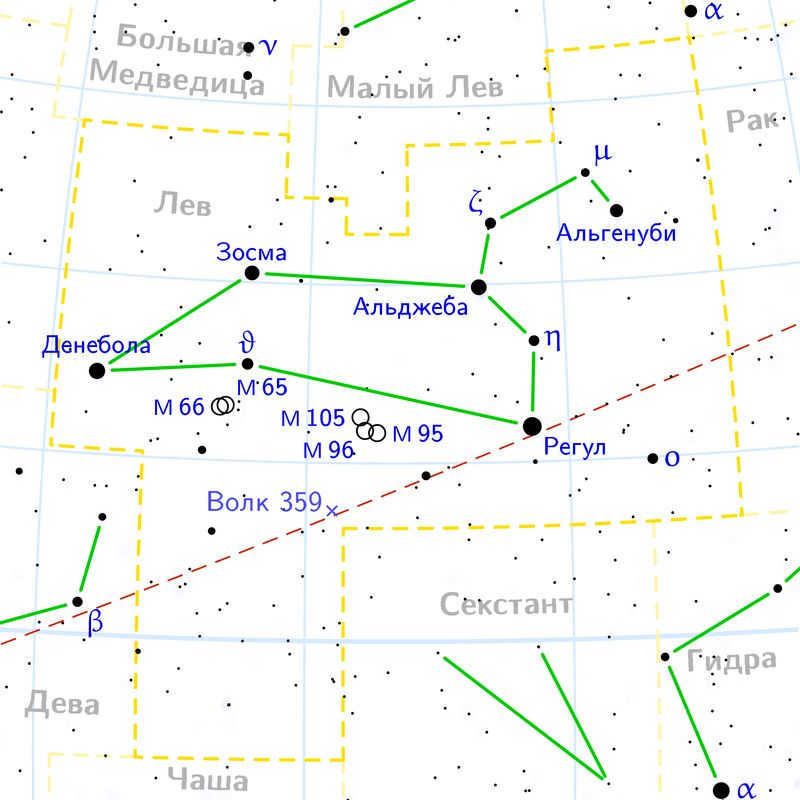
The Leo constellation
This group can be found directly between Leo and Gemini. It is notable for the fact that it is relatively easy to spot a scattered star cluster here. The ancient Egyptians linked this constellation to a sacred creature. It resembles the act of rolling eggs into dung balls, making it easier to roll them further. Such spring constellations are characterized by this kind of movement.
Hydra
The Hydra constellation is situated in the southern region of the constellation Cancer. It is a compact group of stars that forms the shape of a serpent’s head. This celestial formation dominates a considerable portion of the night sky. In Latin, its name translates to “water snake”. The constellation extends in an arc of approximately 90 degrees towards the southeastern direction. The brightest star in Hydra is known as Alpha.
There is an additional captivating tale intertwined with Apollo, who set out to create incense for his father, Zeus. In order to achieve this, he dispatched a raven to fetch water. However, along the way, the raven stumbled upon a date palm and had to pause momentarily until the fruit ripened. Upon realizing that time was running out, the raven concocted a false excuse to justify his delay to Apollo, claiming that a water snake (Hydra) obstructed his path to the water source.
Yet, the gods cannot be deceived, and Apollo discovered the raven’s deceit. As punishment, he banished the bird to the heavens along with the bowl, placing the snake nearby to prevent the raven from drinking water from the bowl.
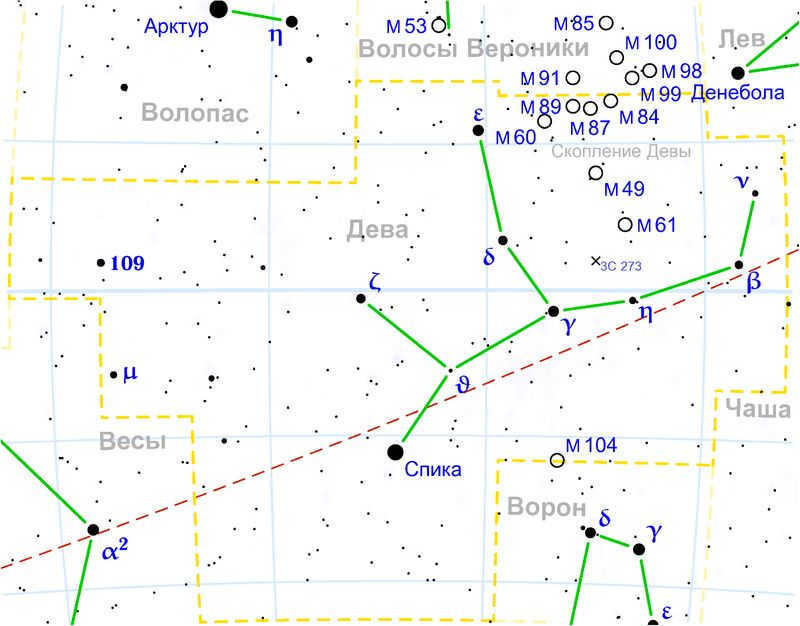
The Virgo constellation
When observing the constellations visible in the spring sky, it is worth taking note of this particular group. It can be easily seen on the left side of Leo and lower in relation to Volopassus. The most prominent star in this constellation is SPIC, which translates to “spike” in Latin. This name is derived from the fact that ancient Egyptians associated this constellation with the time of harvest. Hence the name is closely linked to agricultural practices.
During that time period, women were primarily responsible for carrying out this type of work. As a result, it is not unexpected that the constellation was given a distinctly feminine name. The ancient Greeks chose to call it Demeter. Demeter was not only a central figure in an intriguing tale, but she was also the sister of Zeus. According to the legend, she was the one who bestowed upon humanity the gift of wheat.
Summary
Therefore, we have examined and investigated the primary formations of the spring celestial sphere. This write-up will assist in becoming proficient in the chart and in reinforcing the recollection of specific particulars regarding the precise positioning of the celestial bodies. In the spring sky, there is an abundance of stars and the clusters they congregate into. We have only discussed the principal recognized classifications, which will enable you to become more familiar with the field of astronomy.

The arrival of the spring season brings a fresh change to the night sky in the Northern Hemisphere. As winter slowly fades away, the bitter cold and familiar images of distant space give way to a new display of constellations. Leading the way is the majestic Leo, proudly marching across the celestial arena.
| March | Cancer – Canis Minor – Carina – Lynx – Phalacrocorax – Pyxis – Sails – Volans |
| April | Puppis – Chamaeleon – Crater – Hydra – Leo – Leo Minor – Sextans – Ursa Major |
| May | Canes Venatici – Centaurus – Coma Berenices – Corvus Crux – Musca – Virgo |
Constellations in the Spring Sky

If you want to locate the majestic ruler of the animal kingdom in the sky, the most straightforward method is to first locate the prominent asterism known as the Big Dipper. Just below the “ladle” of this celestial formation, you will find the dazzling star named Regulus, which is also referred to as Kalb al-Asad in Arabic, meaning “lion’s heart”. By mentally extending the handle of the celestial scoop, you can then proceed to locate Arcturus, one of the most luminous stars in the constellation known as Boötes.
Virgo holds the second position in the constellations hierarchy

Among Leo and below both, you can find the stunning Virgo – one of the largest constellations. Only Hydra surpasses it in size, stretching its body across the horizon. Virgo is adorned with Spica, the brightest star in this part of the sky. On clear nights, you can attempt to locate the Cancer constellation between Leo and the departing Gemini, which, despite its small stars, holds special significance as a zodiacal constellation.
As spring takes hold, the winter constellations gradually fade from the sky, sinking lower and lower towards the horizon until they are eventually concealed behind it.
Spring constellations in the night sky
Observing the constellations in the spring sky can be done in the southern region, with the optimal time being April 15th at 11 p.m.. From Russia, you will have the opportunity to see the Centaurus, Leo, Raven, Hydra, Cancer, Virgo, and Bowl constellations. Compared to three and a half months ago, the night sky will appear darker. Back then, you could witness seven of the brightest stars in the southern hemisphere, but now you can only spot three first magnitude stars accompanied by a few faint celestial bodies. Let’s organize these constellations based on their location and the history of their discovery.
| Lion | Léo | Leónis | Leo | 947 | 70 |
| Little Lion | Léo Mínor | Leónis Minóris | LMi | 232 | 20 |
| Virgin | Vírgo | Vírginis | Vir | 1294 | 95 |
| Chalice | Cráter | Cratéris | Crt | 282 | 20 |
| Raven | Córvus | Córvi | Crv | 184 | 15 |
| Sextant | Séxtans | Sextántis | Sex | 314 | 25 |
| Bootes | Boótes | Boótis | Boo | 907 | 90 |
| Scales | Líbra | Líbrae | Lib | 538 | 50 |
| Hunting Dogs | Cánes Venátici | Cánum Venaticórum | CVn | 465 | 30 |
| Berenice’s Hair | Cóma Bereníces | Cómae Bereníces | Com | 386 | 50 |
| Water Snake | Hýdra | Hýdrae | Hya | 1303 | 130 |
| Crab | Cáncer | Cáncri | Cnc | 506 | 60 |
Mythical constellations of the spring celestial sphere
Studying astronomy cannot be done without considering history, particularly the fascinating realm of mythological stories. In the ancient era, humans attributed divine and mythical significance to everything they couldn’t comprehend or explain. We invite you to delve into the exploration of the spring night sky, not only through star charts, but also through captivating anecdotes that shed light on the origins of different constellation names.
Located south of the Big Dipper, along the line that connects Dubhe (α UMa) and Merak (β UMa), and to the east of the constellations Gemini and Canis Minor, lies the constellation Leo. This constellation is easily recognizable in the illustration, as it depicts the unmistakable form of the “king of beasts” with its body and mane. Interestingly, the constellation represents the Nemean Lion from the 12 labors of Hercules. The ancient Babylonians associated this constellation with the scorching morning heat, when the image of a lion ready to pounce could often be seen. The symbol of the constellation also portrays a predator in mid-jump. It was once believed that great kings were born when this constellation appeared in the sky.
To the southeast, you can easily spot two additional bright stars belonging to the spring constellation. Positioned above and shining with more intensity is the orange Arcturus. It is known as the brightest star among the spring stars and is part of the Volopassus constellation. Below and to the right of Arcturus, you can see the bluish Spica, which serves as the head of the Virgo constellation. However, it is also worth noting the constellation known as Veronica’s Hair (located to the right of Volopas, below the Big Dipper), which lacks prominent stars. In Latin, this constellation is referred to as Coma. According to legend, the Egyptian king Ptolemy Everget was married to the beautiful Veronica, who possessed long and beautiful hair. She made a promise to the gods to offer her luxurious hair if the king returned unharmed from a military campaign. Although the king did return unharmed, Veronica’s hair mysteriously vanished from the temple following the ritual. The king was not pleased with his wife’s shaved head. To ease their disappointment, the court astronomer Konon declared that the spring night sky would forever be adorned with the hair of the beautiful woman, as the gods were pleased with the fulfilled vow and the magnificent hair itself.
Located north of the constellation, in the space between Leo and the Big Dipper, we find the constellations Lynx (Lynx, Lyn) which is characterized by a single bright star of third magnitude, as well as the rather unremarkable and faint constellation known as Leo Minor (LMi).
Next to Leo, you can observe the Cancer constellation, while above the mighty Leo, there is a rather unimpressive small constellation called Leo Minor. Moving to the right of Volopas, you will come across the constellations of Veronica’s Hair and the Hound Dogs. Below and to the right of Virgo, you will find a unique configuration of stars, forming a quadrangle of almost equal brightness, which is known as the Raven constellation. In the extensive Hydra constellation, the only easily visible star is α (2m). However, the Sextant and the Bowl, which are located between Hydra and Leo, are so faintly visible that it is nearly impossible to distinguish their shapes. Lastly, below and to the left of Spica, you can spot two stars from the Libra constellation (2.8m and 2.6m), namely α and β, appearing low above the horizon.
Libra constellation is considered to be one of the oldest, but the reason why the ancient people decided to immortalize such an ordinary object remains unknown. It is believed that Virgo with the Colossus and Libra symbolize the economic way of life of traders and farmers during that era.
The Cancer constellation
The inconspicuous constellation Cancer (Cancer, Cnc) is situated between Gemini and Leo. It is renowned for its prominent scattered star cluster, known as the Crèche (Praesepe, M44). In close proximity to the constellation in the spring sky, you can observe the stars of the North and South Donkey. The Cancer sign serves as a reminder to observers that this creature, similar to the sacred scarab beetle, held significance in Egyptian culture. The scarab beetle wraps its eggs in dung pellets, enabling it to roll them while moving backwards. This distinctive movement is depicted in the zodiac sign, with the dung pellets symbolizing the Earth and the Sun.
The Hydra constellation
During the springtime, when the sky is full of stars, you can observe three inconspicuous constellations in the northern part of Hydra. One of these constellations is called Sextans, and it is located south of Regulus and northeast of Alpharad. Another constellation, known as Crater, can be found northwest of Hydra. To the west of Crater, there is a notable group of stars that form the shape of a quadrangle, forming the constellation Raven, or Corvus.
One of the most remarkable features in this region of the sky is a group of stars called the “False Cross.” This group includes stars from the constellations Sail, or Vela, and Kiel, or Carina. The “False Cross” is quite striking, and its direction can be determined by observing ι Sag and δ Vel, which point northward towards the remarkable double star γ Vel. From there, the line extends further to ζ Corma. The other part of the “Cross” is formed by the first magnitude stars κ Sail and the orange λ Sail, also pointing northward.
Looking towards the horizon, one can spot the constellation Centaurus, also known as Centaurus, where the correct Greek pronunciation is used. This constellation is often depicted as a combination of a horse’s torso and the upper part of a human body, according to various artists. The origins of this mythological creature can be traced back to the centaur Nessus, who was responsible for the demise of Heracles.
The Virgo Constellation
Situated to the left of Leo and below Volopas, the Virgo constellation is a prominent feature of the spring sky. One of its brightest stars is Spica, derived from the Latin word “spike”. This name stems from the ancient Egyptian tradition of associating the constellation’s rise with the beginning of the harvest. As a result, the constellation became synonymous with agriculture and fertility. Given that women were primarily responsible for the harvest in the past, the constellation was named after a female figure. The Greeks referred to it as Demeter, the daughter of Rhea and Kronos, and the sister of Zeus. According to legend, Demeter bestowed upon humans the knowledge of agriculture by gifting them with an ear of wheat. Meanwhile, the Romans called the constellation Ceres, who happened to be Jupiter’s sister.
We hope you found this article informative and concise. It not only helps you master the map of the starry sky, but also strengthens your memory of individual star locations through interesting mythological references. If you have the opportunity, we recommend familiarizing yourself with the literature below. Also, be sure to explore other sections of our website, where you can find information on constellations visible from the Russian Federation throughout the year. If you have any questions or need help choosing the right observation instrument, feel free to use the feedback form. We will do our best to provide detailed and accessible answers.
To create a description of the constellations in the spring sky, we relied on the following scientific sources:
The Three Major Constellations of the Spring Sky
Many individuals are interested in learning how to navigate the celestial expanse. However, for beginners, the night sky can appear chaotic, despite its beauty. It may seem impossible to comprehend the intricate arrangement of stars.
The idea of meticulously studying the night sky with a map can be intimidating and deter many people. However, having the ability to navigate among the stars is essential for practical observations. How does one locate Jupiter or Saturn in the sky? Where can the variable star g Hercules be found? How does one pinpoint the position of the globular cluster M3? For those who possess a basic understanding of celestial locations and have access to a star atlas, answering these questions is relatively straightforward.
When studying any case, the main rule is a gradual transition from simplicity to complexity. This principle is especially applicable to practical astronomy. If you want to learn how to navigate the sky, it’s best to start small: Begin by memorizing the brightest stars that are visible in the evening sky, as well as the most prominent star patterns – constellations or asterisms. Once you can confidently distinguish between Vega and Deneb, as well as the constellation of the Swan and the constellation of the Eagle, you can then use these constellations and stars as a starting point to locate and memorize smaller, less noticeable star patterns.
If you pay attention, it’s quite simple to commit to memory the locations of the most brilliant stars in the spring sky. In the southern direction during this season, there are merely three stars that fall into this category. These stars go by the names of Regulus, Spica, and Arcturus. These three stars serve as guides to the most prominent constellations of spring, providing a starting point to navigate and discover the rest of the spring constellations.

Regulus, Spica, and Arcturus are the three primary stars that can be seen in the night sky during the spring season. Image: Stellarium
The star Regulus and the Leo constellation
Regulus is located at the forefront of the Leo constellation, which can be easily identified by its distinct trapezoid shape consisting of four stars and the notable Sickle asterism, representing the chest and head of a mythical predator. Regulus is part of the Leo Trapezium, occupying the lower right corner of the formation. During the early part of spring, the Leo constellation can be observed in the eastern sky during the evenings, while towards the end of spring, it is visible in the southwest sky during dusk.

The constellation Leo is easily identifiable by the unique shape that resembles the body and head of a celestial predator. This distinct figure can be observed in the night sky. Image source: Stellarium
There are two other prominent stars, Arcturus and Spica, situated to the east of Regulus. During the latter part of spring, they can be seen in the southern region of the sky during the evenings.
Arcturus is the brightest star in the northern celestial hemisphere. It stands out due to its reddish hue and its prominent position in the sky, particularly in April and May. Take note of the line of stars extending from Arcturus towards the left and upward, forming the pattern of the constellation Boötes. Some may perceive it as a large letter P, while others may visualize it as a parachute with Arcturus serving as the parachutist at its base.

Arcturus and Spica can be located by starting from the stars of the Ursa Major. Figure: Stellarium
Despite the fact that Arcturus is an extremely brilliant star and is easily noticeable in the star-scarce spring sky, here’s an alternate method for finding it. Look up at the zenith during the evening. Directly above you, you will observe the well-known Ursa Major. (If you are facing north, the Ursa Major will be inverted – the bottom of the Ursa Major is facing south!) Now. mentally connect the two outermost stars of the handle of the Ursa Major with a line.. Extend this line, somewhat curved, about 30° to the south. The line will indicate Arcturus!
If this line is extended further south, we will arrive at the third most brilliant star in the spring sky, Spica.
The star Spica and the constellation Virgo
Spica is the primary star of the expansive yet somewhat unremarkable Virgo constellation. The most notable feature of Virgo is an asymmetrical quadrilateral shape, with Spica serving as the lower vertex. This zodiacal constellation extends on either side of the celestial equator, but lacks stars that are brighter than the 3rd magnitude (with the exception of Spica). Consequently, in urban areas, the distinct outline of Virgo is often obscured by the glare of streetlights.

The constellations of Volopassus and Virgo can be seen in the spring sky. This image was captured by Stellarium.
Due to the fact that the ecliptic passes through the constellation Virgo, the Moon and planets often make appearances here. For instance, in 2017, there was a planet, Jupiter, located near Spica, whose brightness outshone that of any star. Beginners may sometimes mistake planets for stars. However, if you are familiar with the brightest stars and the constellations that are visible during this time of year, you will not be confused by planets – you will immediately recognize that they are not stars!
So, we have become acquainted (once again!) with the three primary constellations of spring – Leo, Volopassus, and Virgo. Referring to them as spring constellations, we are indicating that they are most visible on spring evenings when they are highest above the horizon in the south. However, this does not mean that they cannot be observed at other times of the year! It also does not mean that they will be visible, for example, in the pre-morning sky in May. During that time, the southern part of the sky will be occupied by the constellations of summer. We will focus on those constellations in our next discussion.
The constellations of the spring sky are visible in the southern region of the sky. The most suitable and convenient time to observe them is in April. People living in Russia will have no trouble spotting Hydra, Virgo, Cancer, Cup, Leo, Corvus, and Centaurus. During this time, the night sky appears both dark and enigmatic. This article will explore the constellations that can be seen in the spring sky, the myths and legends connected to them, and whether they possess any distinctive features.
Groups of stars in mythology
When studying the constellations in the spring sky, it is impossible to ignore the historical significance that the stars have held for centuries. In ancient times, people associated various processes and phenomena with the stars. Below, we will explore the main groups of stars, their historical references, and their unique characteristics.
This particular constellation can be found to the south of the Big Dipper and to the east of the Little Dog. It is quite easy for the average person to notice the distinct mane and torso pattern, as it is quite characteristic. The arrangement of stars gives the impression of a predator ready to leap. In the past, it was believed that the appearance of such spring constellations in the sky indicated the birth of a great king in the near future. The brightest star in this constellation is Regulus, which is classified as a first magnitude star.

The Leo constellation
Located directly between Leo and Gemini, this group stands out for its easily identifiable scattered star cluster. In ancient Egyptian culture, this constellation was associated with a sacred animal. It is reminiscent of rolling eggs into dung rolls, allowing for convenient rolling. Such spring constellations encompass this type of movement.
Hydra
This cluster is situated in the southern region of Cancer. It constitutes a compact formation, representing the head. It is this particular entity that occupies a substantial portion of the celestial sphere. The precise denomination, derived from Latin, is “water serpent”. It extends in a curvilinear fashion towards the southeast, spanning an angle of 90 degrees. The most luminous celestial body within this constellation is Alpha.
If we are to trust the ancient tales, Hydra was always found in close proximity to marshes and had a voracious appetite for both humans and animals. It possessed multiple heads, with the exact number varying in different accounts, but generally ranging from 9 to 100. These spring constellations were mentioned in the legendary exploits of Heracles, who attempted to sever the creature’s heads, only to witness new ones sprout in their place. Faced with this seemingly insurmountable challenge, Heracles ultimately decided to take a different approach by setting fire to the surrounding forest. Fortunately, he received assistance from the renowned Rak, who bravely bit the monster’s leg.
However, the deities cannot be fooled, and they discovered that Raven had deceived them. As a punishment, they banished the bird to the heavens with the bowl and placed a snake next to it to prevent Raven from drinking water from it.

The constellation Virgo can be observed in the spring sky. It is located on the left side of Leo and lower in relation to Volopassus. The brightest star in this constellation is called SPIC, which means “spike” in Latin. This name is derived from the association of the constellation with the time of harvest by the ancient Egyptians. Therefore, the name is related to the agricultural craft.
During that time, women were primarily responsible for such tasks. As a result, it is no wonder that the group of stars was given a distinctly feminine title. The ancient Greeks referred to it as Demeter. Additionally, she was the protagonist of a captivating tale and was also Zeus’ sister. According to the myth, she was the one who bestowed upon humanity the gift of wheat.
Summary
In conclusion, we have examined and explored the primary constellations visible in the spring night sky. This article will assist in familiarizing oneself with the star map and reinforcing the retention of specific details regarding the precise positions of these celestial bodies. The spring sky offers an abundance of stars and the clusters they form. We have focused on the key well-known categories, providing an opportunity to delve deeper into the fascinating field of astronomy.
Spring star formations
Spring star formations may not be as dazzling and vibrant as their winter counterparts, but they offer a convenient viewing experience. The spring sky tends to be dark and clear, making it easier to observe celestial objects. Additionally, the warmer weather and lack of airborne dust create more pleasant conditions for stargazing compared to winter. Furthermore, during early spring, it is still possible to spot winter constellations in the western part of the sky, positioned relatively high above the horizon.
So, what can we expect to see in the evening sky during mid-spring, say, on April 15th? While the abundance of bright stars may not be as prominent as in winter, there are still three noticeable first magnitude stars in the southern region that capture attention.
Constellations of the Spring Sky
Located high above the horizon in the southern region and slightly to the right of the celestial meridian, you can find one of the three brightest stars known as Regulus, which serves as the alpha star in the Leo constellation. This particular constellation has a unique and easily recognizable figure that stands out prominently in the night sky.
When looking towards the southeast, two more prominent stars come into view. The star positioned above, shining brighter and displaying a yellowish hue, is Arcturus, the alpha star in the Volopassus constellation. It is considered the most brilliant star in the spring sky. Directly below Arcturus is Spica, another star of nearly equal brightness, which serves as the alpha star in the Virgo constellation.
Leo, Capricorn, and Virgo are the primary constellations that dominate the spring sky, boasting the most distinctive and captivating features. While there may be other constellations present during this season, they tend to be less prominent and notable.
To the right of Leo, you can find the Cancer constellation, and above it is the Leo Minor constellation, which doesn’t have anything noteworthy in it. On the right side of Volopassus, there are the Hound Dog and Veronica’s Hair constellations.
To the right and below Virgo, there is an irregular starry quadrangle that forms the Raven constellation. The elongated Hydra constellation is only notable for its 2nd magnitude alpha star, while the rest of the stars are much dimmer.
Between Leo and Hydra, you can spot the Chalice and Sextant constellations, although they are quite challenging to see due to their faint stars. However, on a dark night with binoculars, it is possible to explore this area.





